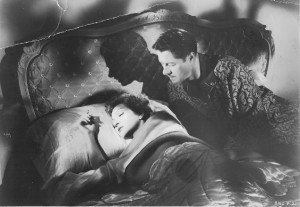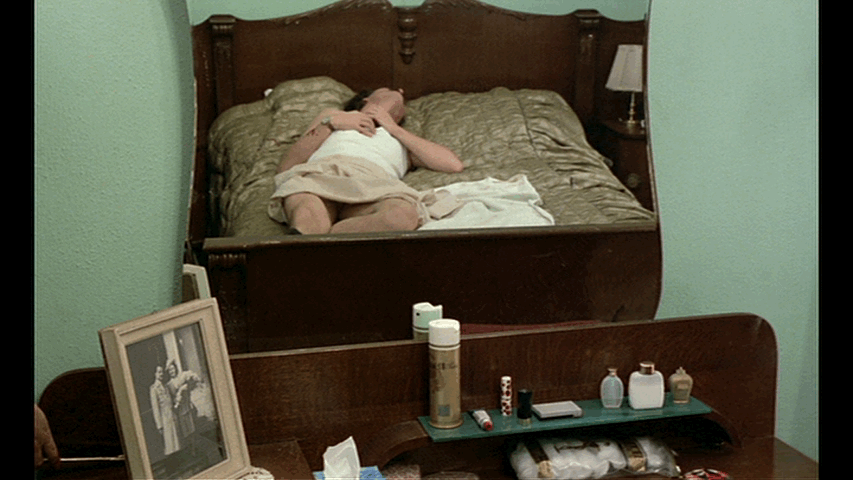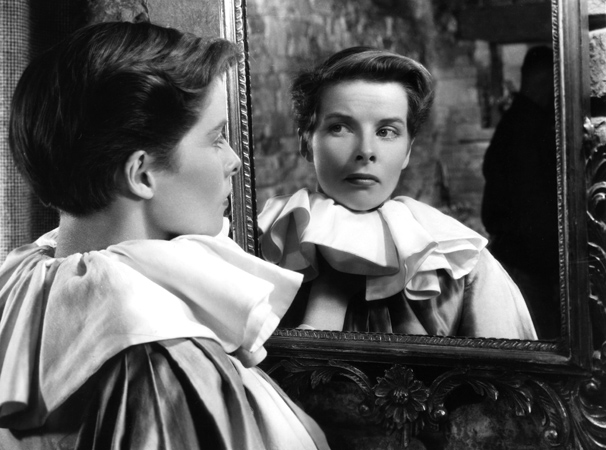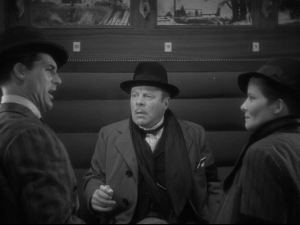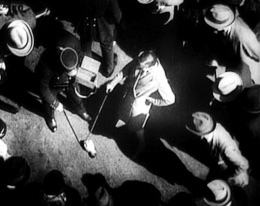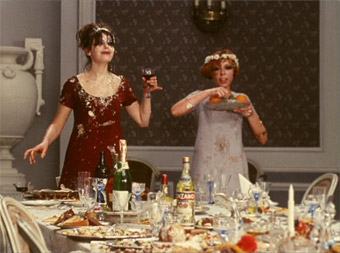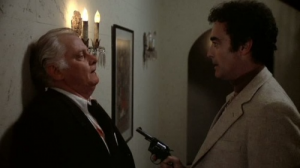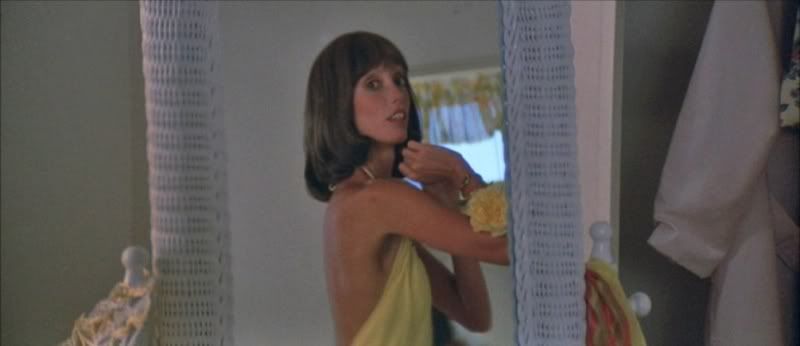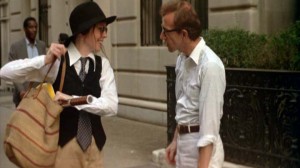From Film Comment (July-August 1977). After I returned to the U.S. early that year after seven and a half years of living in Europe (Paris and London), my “Paris Journal” and “London Journal” column in Film Comment became “Moving,” a preoccupation that eventually yielded the title of my first book, Moving Places.
Note: the 35 mm screening of JEANNE DIELMAN alluded to here was set up by Manny Farber and Patricia Patterson on the University of California, San Diego campus while they were working on the last of their essays. -– J.R.
How to keep moving in the same way that this column must travel — from La Jolla, to Richard Corliss in Cannes, to Film Comment in New York, to wherever you happen to be reading it? Now that TV Guide generally has to take the place of Pariscope, [London’s] Time Out, the New York newspapers, shall I write about the breathneck beginning of Sirk’s SLEEP, MY LOVE, the parallels with Preminger’s WHIRLPOOL,a wonderful exchange between Don Ameche and Hazel Brooks (”Doesn’t sound like my girl…” “You have a lot of girls. This is one of them”), or scenes that unexpectedly and mysteriously take place in the rain? Better to leave such fine points to the auteurists.
I’m still recovering from my third look at Chantal Akerman’s JEANNE DIELMAN, a new movie which I was finally lucky enough to catch outside a film festival and on a big screen. It’s amazing what a little bit of time on one’s hands and an epic space can do for an epic movie; what initially provoked some resistance — over three hours of concentration on a woman’s life, mainly housework -– now becomes all-absorbing, even monumental. How long will it take before many others get to see it in such conditions, or in any condition at all? Better ask the auteurists about that one, too. Chances are, they’d rather tell you what’s right or wrong with BLACK SUNDAY.
Original soundtrack recording of Bernard Herrmann’s TAXI DRIVER score, side two, track two, bridge of the first chorus: an unidentified muted trumpet (and later, muted trombone) begins to play in a different key from the accompanying strings and piano, which up to then have been caressing Tom Scott’s alto sax theme in a conventionally romantic, jazzy penthouse harmony. A plush, gaudy reverie on Cloud Nine — identified with comparably upholstered glimpses of Cybill Shepherd in the movie — slides almost imperceptibly out of the chordal comfort of Hollywood’s notion of wistful sanity and into a subtly splintered realm of two adjacent frameworks weirdly out of whack, each humming and buzzing away in mutual alienation like a Joan Didion heroine on Seconal. But like all suspension bridges, it leads straight back to safety, the sweet terra firma of a Hollywood platitude -– a repeat of the dreamy alto theme. Even the madness has been illusory.
But what if it’s the spacey bridge that suggests sanity, an escape from the lunacy of the Hollywood wish-fulfillment? Like Elliott Gould singing, whistling and humming fragments of “The Long Goodbye” out of tune and out of synch with an offscreen piano trio, it may only suggest a temporary misalignment of clichés as they’re set in front of a distorting mirror — a glancing, ironic twist to the same old song and dance.
***
“Why walk along a rope and yet squat down every four steps?” Notice the ugly dent that squat down makes in that suspension. This interesting question about poetry (by Saltykov-Shchedrin, cited in a Viktor Shklovsky essay) comes back to me as I marvel at Katharine Hepburn’s happy capacity to make all her bones dance in SYLVIA SCARLET. The latter is playing down the street at a local theater in La Jolla, appropriately known as the Unicorn, which is appropriately located inside an occult bookstore.
If bringing elegance to what is otherwise an inelegant activity (like squatting) can be counted as one of the procedures of poetry, the whole giddy movement of Cukor’s tragic farce as it wildly shifts key signatures from one sequence to the next — from Dickens pathos, Tarkington cuteness, and Twain subterfuge to commedia dell’arte, from dandified drawing-room affectation and genteel, domesticated nineteenth-century fantasy to seedy music hall-suggests one plausible reason why this curious 1936 mélange originally suffered a quick extinction at the box office.
After assigning my art criticism class to write about it, two students complain that they can’t see why I pick such a naïve piece of tripe. It emerges that they went at seven o’clock, when the audience apparently treated all the strange goings-on — John Collier’s salty dialogue, Hepburn moving (in drag and out) pretty much the way that Jean Cocteau writes, and Cary Grant pursuing a sinister, beefy improvisation on his Cockney background — as ludicrous camp fodder. When I went at eleven, the audience was more sparse and quiet, less intent on making the dream-bubbles burst. As night creatures in the Unicorn’s belly, we were perhaps more prone to accept Edmund Gwenn, a fallen father rolling in the grass at a magical moonlit picnic, crying in his alcoholic sleep while a Russian beauty tormented him shamelessly for laughs; or BrianAherne’s bucolic homestead, a gorgeous Disney cottage the size of a musical comedy sound stage.
The same week, I show UN CHIEN ANDALOU twice in a row in my film course: first with a Franck symphony, then with the soundtrack score of PLAYTIME, a film we studied a month ago. Was it the rollicking Muzak, Buñuel, my head, or some secret collaboration between the three that fleetingly suggested a street crowd, gathered around a disembodied hand had some of the quirky, comic ambience of Tati extras? “Using different kinds of music as accompaniment to UN CHIEN ANDALOU,” runs part of my subsequent true-false quiz, “changes the nature of the film profoundly.” Most of the students decide this statement is true.
But if it is, what does that make of filmgoing and film criticism? Did the students in my criticism course and I see different films at the Unicorn? Is UN CHIEN ANDALOU a different film every time you switch cassettes? “Naked Lunch demands Silence from the reader,” writes William Burroughs. “Otherwise he is taking his own pulse. . . .” Pulse readings comprise a good ninety-five percent of the way films are being seen and written about — one reason, perhaps, why most film-reviewing reads like advertising in drag. Textual analysis gives way to market research, and by now few among us are able to distinguish between the two. Those who try are usually labeled formalists, or pedants.
***
January in London: Being especially partial to artworks that put me on the spot — from William Gass’s On Being Blue to Luc Moullet’s LES CONTREBANDIERES to Philip Glass’ Music With Changing Parts to Iris Owens’ After Claude — I discover that Vera Chytilova’s unbearable DAISIES, turning up at a National Film Theatre Czech season, is right up my alley.
A curious split in the audience’s reactions helps to define the irritation more acutely: by and large, the laughter I hear comes from women, not from men. As the two dotty, interchangeable heroines tear through the movie and its countless formal procedures like maniacal children on a murderous rampage — chopping up bananas and several comparably shaped objects in a giggly anti-phallic delirium – I’m already getting edgy. And when they exert their carnage on a banquet table laden with expensive goodies at the end, proceeding beyond comedy into an endlessly protracted nightmare of flesh and food that’s every bit as disturbing as Pasolini’sSALÓ, I realize I’m in the presence of something that I can’t diminish or even control with any amount of rhetoric or film theory.
***
March in L. A.: Seeing Rivette’s NOROÎT for the third time at Filmex, I find it as creepy as ever, but I’m not so sure hat this is because of all the “images of castration” that my psychoanalytically-inclined friends keep alluding to –- by which they mean a lot of female pirates. I’m more tempted to think that Rivette’s effort to expel the “real world” once and for all (apart from the brutal assault of images and direct sound) merely reverts, like a surrealist tactic, to a monstrous form of self-exposure in the mise en scène that is at once omnipresent and invisible, like a poisonous vapor — making NOROÎT into as much a cousin of NOSFERATU as Welles’ OTHELLO. But what I find unnerving and compulsively exciting is described by others as “self-indulgent”– a nice nonanalytical term used to blanket over rejection of all sorts of challenges nowadays, from MIKEY AND NICKY to IN THE REALM OF THE SENSES to RAMEAU’S NEPHEW. I might even be willing to accept that epithet if I understood what it meant.
***
April-May in L.A.: A weekend mainly wasted on trifles that get all the star billing. AUDREY ROSE: a mindless, soporific absurdity about reincarnation that gets reviewed everywhere, thus implying it’s a lot more vital than JEANNE DIELMAN, which no one will squat down and write about. THE LATE SHOW: only intermittently relieved by waiting for moments when Lily Tomlin can outclass her dopey dialogue, and mainly stuck in endless Tales from the Crypt where pleasant memories of Hitchcock, RIO BRAVO, and THE LONG GOODBYE get dehydrated, battered together, balled up, and flattened into puny pancakes, like the inglorious waffle that NICKELODEON made out of John Ford and slapstick.
3 WOMEN: Altman and various critics’ testimony to what can happen to minds which think that modernism can be applied without ever being assimilated, much less confronted. A Forties Hollywood art film with little of Val Lewton’s finesse, apart from those slow Piscean blue dissolves that make it more contemporary, and a dream sequence that can seem possible only to someone who hasn’t even scratched the surface of the French avant-garde in the Twenties, automatically associating all such issues with Bergman. And, for the humanists in the audience, an invitation to not feel tacky and unobservant while feeling superior to the unobservant tackiness of the Shelley Duvall character, echoed in the knowing chuckles that Altman pulls out of me and everyone else.
ANNIE HALL: a marvelous trifle because at least it gives an audience a warm sense of itself, a graceful way of sliding across all the vaudeville turns of the narrative, and the first indication that Woody Allen can sustain a whole film under his own direction. Even if it changes nothing essential, either about him or about ourselves.
Generally speaking, the parties in Hollywood are more fun than the movies because they provide more swagger and drama; more comedy, too, in their paranoid dislocations. Meredith Brody, ]ohn Milius’ story editor, sums up the atmosphere succinctly: “In order to be happy here, you not only have to succeed — it is also necessary for your best friends to fail.” No wonder all four of the movies cited above deal so doggedly with guilt.
There’s plenty of guilt in Godard, too. But when I attend a Sunday afternoon screening at UCLA of ICI ET AILLEURS and COMMENT ÇA VA, two movies he made last year — both untranslated, and attended by what appears to be about a dozen people — I feel, for the first time this weekend, that something concrete is being done about it. But you aren’t likely to find out about this by reading the national critics. Given the hysteria in this country aroused by pro-Palestinian sentiment, you probably won’t get many chances to see ICI ET AILLEURS at all.
So what can I do to help you out of your dilemma? Not much. I can only keep up with seventy percent of the French in ICI ET AILLEURS, and the experience of this short feature and its dazzlingly diverse forms of accumulation — actors, photos, numbers typed on a calculator, multiple TV screens and slides and what the film calls “turning up the sound volume too loud” — leaves me too exhausted to determine whether COMMENT ÇA VA is a dull synthesis of earlier Godard or a try at something else which exceeds my understanding. For all I know, it could be both.
What do I remember about ICI ET AILLEURS? Faces of Palestinian soldiers training in refugee camps, slowly coming into focus, followed by an announcement that “nearly all of these actors are dead.” Different lights flashing on and off around three-dimensional letters spelling out LEARN TO SEE, NOT READ, changing their shadows. Processes of repetition, sound-image juxtapositions and varying durations that suggest Jean-Daniel Pollet’s MEDITERRANÉE (which you won’t get to see either), but spaced out with a rhythmical delicacy that suggests dancing more than walking. Then, “en repensant de cela,” a critique by Anne-Marie Miéville of the mise en scène that Godard has been passing off as something else; the word PALESTINE changing gradually into the word ISRAEL; Kissinger split into “kiss” and “SS” next to a photo of his eagle eye aimed at these divisions. Through everything an overwhelming demonstration that Godard is a much greater showman than Robert Wise.
That’s not much to report, but after one screening, even this minimal selection is a lot more than I’m equipped to deal with. I’d welcome help from any of my colleagues, if they can tear themselves away from the remake of A STAR IS BORN or ISLANDS IN THE STREAM or any of the other saturation-booking specials that consume their columns. If commerce rules that the film has to be in distribution, they could always start with something else. Can anyone with an ounce of sense believe that AUDREY ROSE has to be more interesting and important than LA RÉGION CENTRALE? It might be fun to see someone try to prove such an assertion. The worst that could happen would be getting it wrong, and that happens all the time anyway. At best, it might give everyone a better chance of seeing and understanding something new for a change.
Published on 08 Apr 2013 in Notes, by jrosenbaum

